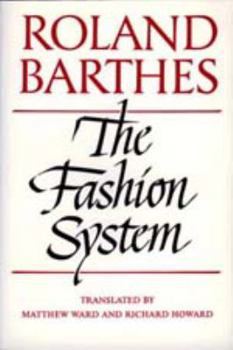The Fashion System
Select Format
Select Condition 
Book Overview
In his consideration of the language of the fashion magazine-the structural analysis of descriptions of women's clothing by writers about fashion-Barthes gives us a brief history of semiology. At the same time, he identifies economics as the underlying reason for the luxuriant prose of the fashion magazine: "Calculating, industrial society is obliged to form consumers who don't calculate; if clothing's producers and consumers had the same consciousness, clothing would be bought (and produced) only at the very slow rate of its dilapidation."
Format:Paperback
Language:English
ISBN:0520071778
ISBN13:9780520071773
Release Date:July 1990
Publisher:University of California Press
Length:351 Pages
Weight:1.01 lbs.
Dimensions:0.8" x 6.0" x 9.0"
Customer Reviews
2 ratings
Fashion Lovers MUST READ
Published by Thriftbooks.com User , 15 years ago
For anyone interested in fashion (the real essence of fashion) you need to get this book. Being that I am a designer, I am using this book to fully understand the superficial meaning of clothing and fashion. I feel it is very good for people to understand not only what (art of fashion is) but also to understand how others perceive this (art)...This book does this very well. If you don't LOVE fashion and everything about it (ever the psychology of fashion) ...I don't recommend this book. Barthes is the first (ever published) to really look at fashion with a semiotic approach.
Center/Fold
Published by Thriftbooks.com User , 24 years ago
For any reader who has had a father that read *Playboy* "for the articles," even Barthes' highly analytical approach to the relation between image and text--which he insists *produces* Fashion or "real clothing"--can be funny. I.e., reading in translation the American reader may not identify so much with the eccentricities of Barthes' style so much as his choice of subject. Barthes' work remains entirely relevant, even though the book was published in 1967--the decade where fashion models withered, along with any grand sense of ethics on the part of commercial artists, clothing designers, and filmmakers, down to nothing. Perhaps Barthes would say this Nothing was a *commentary.* Perhaps not. But certain details of Barthes' analysis hold very interesting still: for example, the fact that Barthes refers to the way the "written-garment" in a layout calls attention to specific portions of the "image-garment" as "amputations" (15). For the reader, it's important to place the book into some sort of context, as Context is Barthes' entire position when he insists that in relation to popular imagery, text "arrests the level of reading at its fabric, at its belt, at the accessory which adorns it" (13). Barthes' idea that the language used by magazine writers does not comment upon but rather *creates* Fashion arouses some questions about certain social centerpieces in, for example, popular (once "folk") music: Janis Joplin to Madonna to Britney Spears. While Barthes clear interest is a structuralized definition of Fashion, not women, studying Barthes' book may help us understand at a more analytical level just what these women "mean" as they are mediated through imagery and arrested by their respective (worn and written) articles. Barthes is crucial for anybody who has ever noticed that, compared to that which accompanied artists of Joplin's caliber , the accompanying texts of contemporary magazines read, more often than not, like a report of Time Temperature and Date. Furthermore, the book certainly becomes enjoyable for the more fantastic-minded who could envision a day when fashion magazines no longer have to rely on flamboyant nudity, tasteful or otherwise, or suggestive postures, but wherein nudity and erotic positions are implied in a truly Barthean, truly erotic manner: by the fact that all text has been stripped bare. After all, even in a picture-mag where there is no writing, there is still, if one reads Barthes, *writing*. This reviewer would imagine that in Barthes' eyes, the old fashioned critique of the ironic incongruities between the image and the text of other vestments of fashion (such as shampoo commercials whose orgiastic imagery and sounds have nothing to do with the actual product) could be easily solved by one magazine, of any kind, that had no writing at all but consisted entirely of centerfolds.







